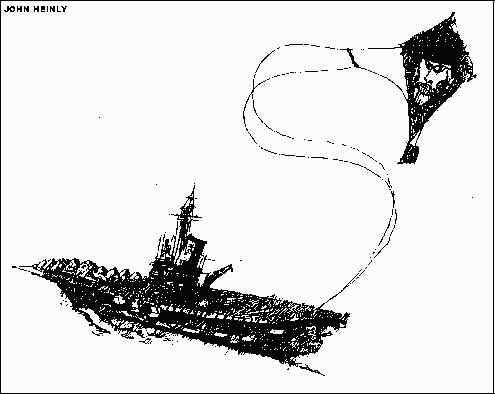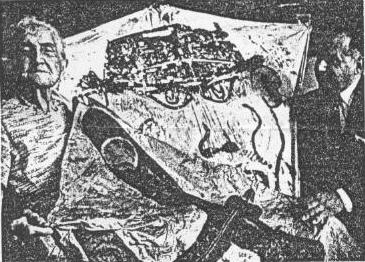The Kites of War
Washington's Paul Garber recalls his unique contribution to World War IIby George C. Wilson

The Kites of WarWashington's Paul Garber recalls his unique contribution to World War IIby George C. Wilson |

|
THE OFFICERS and men on the aircraft carrier Block Island laughed when word got around that a full grown lieutenant was making a kite. A war was going on - this was early In 1943 - and Lt. Paul Garber of Washington apparently wanted to play games.
But before the war was over, the Navy had ordered and used more than a quarter of a million of the Garber-designed kites, and at the end of the war awarded the inventor a commendation.
Garber, who now is head curator of the Smithsonian's National Air Museum and whose aviation experience dates back to those first uncertain days of flying the mail, had been thinking about a special kind of kite for some time - even while he was still a civilian, working as associate curator at the museum.
He intensified this thinking right after the Japanese bombed Pearl Harbor. The Navy, one day after the attack, asked Garber to use his expert knowledge to develop an aircraft recognition program. A year later - in his Navy lieutenant's uniform - Garber was on the deck of the Block Island watching the gunners practice by shooting at puffs of smoke made by exploding shells from their own guns. They were taking little interest in their work, mostly because there was no way to know when they had scored a hit. Lt. Garber had an idea. He went down into the hold and found the makings of a kite - sail cloth, line and light sticks. "Everybody laughed at me," he recalls. "Here was a full grown Navy lieutenant in his early 40s fooling around with a kite."
Soon he had the kite flying out from the fantail of the Block Island. He challenged the gunners to shoot it down. Lt. Garber maneuvered the kite evasively, and the gunners had a devil of a time hitting it. Finally, a burst hit home and the kite came circling down into the sea. The gunners cheered and slapped each other on the back. The carrier skipper came aft from the bridge to see what the commotion was all about. Sizing up the situation, the skipper ordered Garber to make another kite for gunnery practice later that day and a kite for every subsequent day's practice.
What evolved was a diamond kite (five feet by rive feet) with a rudder arrangement for steering, but no tail. Lt. Garber's long-time friend and then shipmate, the late Stanley Potter of Alexandria, helped with the development. The kites could duplicate most maneuvers of an airplane and were usually flown about 250 yards out from a ship so they would took about the same size as an attacking plane.
Word of the kites spread quickly through the Navy, reached the ears of the brass in Washington and, eventually, led to a notable meeting on the roof of the main Navy Department between Lt. Garber and the late Adm. Luis deFlorez, head of the Special Devices Division of the Bureau of Aeronautics.
"I don't have time to fly kites; we've got a war on." the admiral had snorted when Lt Garber first described his gadget. Soon, however, they were on the roof and Lt. Garber had the kite flying high above the Lincoln Memorial and the Reflecting Pool. He put it through a series of maneuvers - loops, figure-eights and dives.
"That thing needs a tail," the admiral exclaimed as he watched those maneuvers.
"No, it doesn't," replied the junior officer. "It's under precise control." With that, Lt. Garber had the kite spell out the admiral's name in the blue sky over wartime Washington.
"That's the best damn target I ever saw," the admiral finally admitted. He ordered Lt. Garber to drop everything else and go build six more of them before the end of the day. With the help of Mrs. Viola H. Baker, who now lives at 4639 N. 20th Place, Arlington, Lt. Garber met that deadline. Mrs. Baker, now 95, recalls bouncing along in Lt. Garber's jeep as he rushed her to the station to catch the train she thought she would miss because of working so late sewing together muslin covers for the kites.
Those six kites delivered to Adm. deFlorez were the first of more than 300,000 the Navy eventually bought during the war to sharpen the eyes of anti-aircraft gunners. The target kites - with Japanese Zeros, German FW 190 or other enemy aircraft painted on them - were used at United States and overseas bases as well as on ships at sea.

Mrs. Viola H. Baker and Paul Garber with two of the kites she helped him make during World War II to sharpen the eyes of Navy anti-aircraft gunners. |
Lt Garber's travels with his kites eventually led to the Navy's PT boat school at Melville, R. I., where one of his sons, Ned Garber, was in training as a gunner's mate. PT school leaders were enthusiastic about the kites. One PT boat would fly a kite astern in evasive maneuvers while the other boats in the squadron tried to shoot it down as they roared along. Lt Garber's son was chosen to instruct others at the school in kite handling.
The senior Garber's East Coast tour of gunnery stations and further demonstrations at sea sold the Navy completely on his kite. It ordered 50,000 more of them in a second big order. Spalding, the sporting goods manufacturer, got that contract. This order was followed by two more orders of 100,000 kites each.
Garber, when he thinks of the fancy drones which in 1944 began replacing his kites, likes to tell of the rainy day aboard the heavy cruiser Amsterdam when a hard-pressed gunnery officer could not get his drone's engine started - no matter how loudly the skipper shouted. "When I call for gunnery practice," said the skipper, "I want those things to work." Then he turned to Garber and asked: "Will those damn kites of yours fly in the rain?" They could, and did - as they always had.
The Navy at the end of the war awarded Garber, who had been promoted to commander, a commendation for his kite work and released the patents to him. Garber tried to produce his kite commercially after the war, but manufacturers refused to build it to his specifications on grounds it would be too expensive to sell - about $15 each. Rather than reduce quality, Garber abandoned his commercial efforts.
He feels the kites do not owe him anything more, anyway. There was the day a battleship skipper sought out the kite commander, pumped his hand and exclaimed: "Your kite saved my ship. If anybody ever again says 'go fly a kite' to me I'll bust'em in the nose." He explained that his gunners had been practicing on the kites one foggy day while the battleship was on Pacific duty. Suddenly, out of the fog, came a surprise kamikaze attack. The gunners merely had to swing their guns away from the kite and shoot down the suicide airplane. "We never would have had time to get to our battle stations if it weren't for your kite," the skipper told Garber.
But Garber's biggest reward from his kites concerns his son, Ned, who had been assigned as kite instructor at the Melville PT school. Ned tried to get off kite duty and join his PT boat when it was ordered to sea. The PT school skipper refused the request. Ned did get on a PT boat later and saw combat duty in the Philippines. But his first PT boat was lost with all hands.
A Garber-made kite still is flying, not the type that contributed to the war effort, but a more conventional kind. Kenny Garber, 8-year-old son of Ned, has it and flies it regularly near his home in Hyattsville. It is consoling to Kenny's grandfather that a Garber kite is now doing what comes naturally to kites - giving pleasure to a young boy.